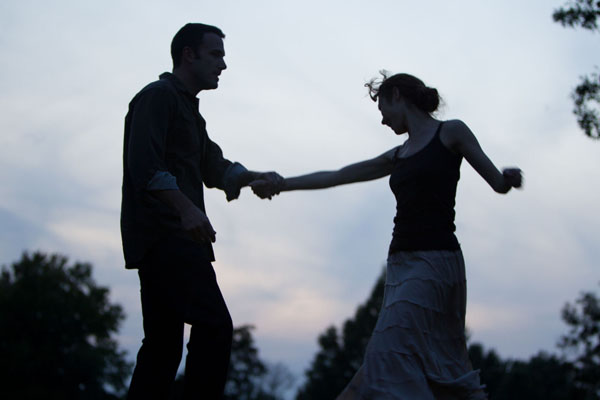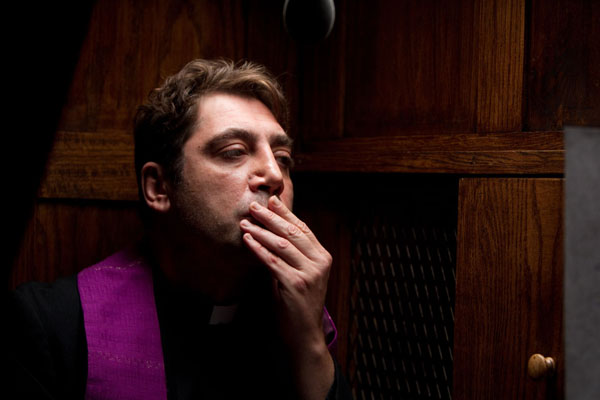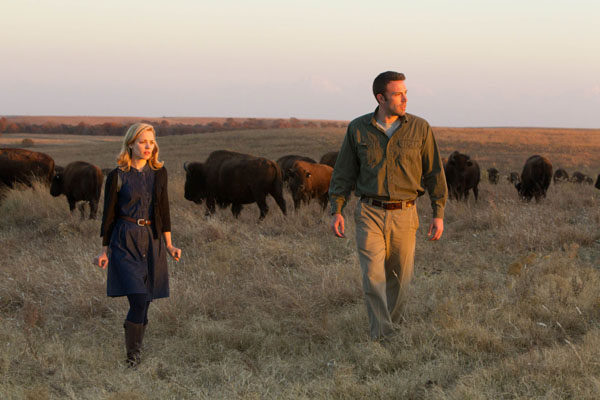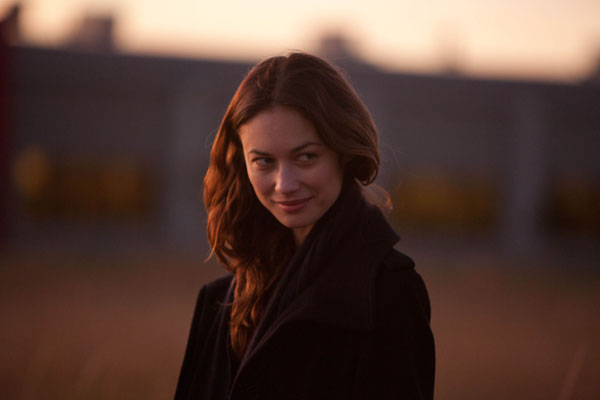Round 3. Having surveyed reviews coming out of last year’s Venice and Toronto festivals, and then wrestled up a second batch when the film opened in the U.K., I can now report that, as it arrives in stateside theaters, Terrence Malick’s To the Wonder is no closer to forging a consensus. J. Hoberman, writing at Artinfo, finds it “so unabashedly maudlin and vulnerable that it’s difficult to generate much animus. The movie may be a two-ton gossamer web, but it’s spun from gossamer none the less.” But the New Yorker‘s Richard Brody argues that “Malick has directed another love story that deserves to endure as an artistic landmark, a love story that, in an age of radical cinema, redefines the very idea of a love story, while remaining faithful to the high line of movie tradition.”
It is, of course, famously, the last movie Roger Ebert reviewed (thumb most definitely up). And it’s the first subject of Variety‘s new “3-View” column in which “our trio of top critics take on divisive pics from conflicting angles.” For Scott Foundas, “this is the first Malick movie since Badlands in which ordinary human problems loom as large as the moon and stars,” but for Peter Debruge, it’s the sort of movie “that reveals the flaws of the masterpiece that preceded it.” And Justin Chang asks, “Skeptic or true believer, has any director done more to advance the simple notion that God is love?”
But let’s back up. “The story, such as it is,” explains Max Nelson in Film Comment, “concerns an American man whose unspecified job involves unrolling blueprints at muddy development sites, and the French woman he takes back home, stubbornly refuses to marry, loses, reclaims, weds, and abandons—and with whom he is finally, undeservingly reunited. He is played by Ben Affleck, who does very little and does it quite well, and she by Olga Kurylenko, an exceptionally gorgeous woman transformed under Emmanuel Lubezki’s worshipful lighting into an impossibly gorgeous one. The couple dance through the streets of Paris and the supermarkets of American suburbia, raise their arms to sunset-drenched skies, make love, turn on one another, drift through doorframes, and keep dancing, as Malick’s camera swoops, arcs, curves, bends, and dives around them. It is all excessive, glorious, overbearing, sexy, and deeply exhausting.”
“As Kurylenko and Affleck drift away from each other,” writes Scott Tobias at the AV Club, “the latter into the arms of an old flame (Rachel McAdams), Malick cuts away to the tangentially related journey of disillusioned priest Javier Bardem, who has a harder time than his parishioners in communing with God. His vocation brings him into the homes of the poor and the wretched, and it shakes his faith—at least insofar as he ever had any. Bardem shares a scene or two with Affleck, but mainly just to establish them as occupying the same cinematic universe. He exists more as the roving conscience of the film, like the crumbling bridge between man and transcendence. Bardem’s dilemma is the central one in To the Wonder, and Malick does his best to make it ours, too.”
“Throughout To the Wonder, the new and old are incessantly twinned, blurred into a package that suggests an experimental dance piece,” writes Slant‘s Ed Gonzalez. “The film’s themes—among them the panic of the spirit, the precariousness of land and human interaction—are familiar sermons for Malick, and given his propensity toward religious sentiment, that shouldn’t be read as insult, especially to parishioners of the Church of Terrence Malick. But To the Wonder, which is cut from an aesthetic cloth far wilder in construction than The Tree of Life‘s, is close to folly, an undisciplined doodle lush with big ideas, but dully imitative of Malick’s previous high notes and cringingly reductive of immigrant experience. To say so feels like a confession, but doubt, in the words of German-American theologian Paul Tillich, ‘isn’t the opposite of faith; it is an element of faith.'”
Michael Koresky in Reverse Shot: “Minus the grand narrative or thematic hooks of his recent work (World War II in The Thin Red Line; American history and myth in The New World; the creation of the universe in The Tree of Life), To the Wonder nevertheless feels as momentous as them—simply by being, by watching, by moving and cutting and floating and wandering it makes an alien space of our world. And as is always true, we cannot make sense of this world unless we are privileged to take on another’s perspective of it. One could say this is Malick’s philosophical project. In this sense, his cinema is a grand empathetic gesture.”
“And the politics?” asks Time‘s Richard Corliss. “Bartlesville [Oklahoma, “where he grew up, and where his geologist father examined oil spills, as the Affleck character does”] is an oil-dependent community facing inundation by the same tar-sands crude seepage that recently forced the evacuation of 21 homes in Mayflower, Ark., 150 miles to the east. As a Bartlesville resident says, ‘Sometimes we see tar comin’ out the cracks in the patio.’ Shot four years ago, To the Wonder can be seen as a ripped-from-the-headlines screed against the Keystone pipeline and, in grander terms, America’s oil addiction. Be warned: the central romance and plea for environmental caretaking simply provide the scaffolding for a modernist symphony of enigmatic figures and pristine nature, as captured by Emmanuel Lubezki’s ever gliding Steadicam. To the Wonder pushes cinematic experiment to a degree not previously attempted by Malick—or, really, by anyone working in narrative cinema. It’s a sound and light show of the most challenging and rewarding kind.”
“The big knock against the movie so far is that it verges on self-parody, all ponderous voiceovers and classical gas and people running like Maria von Trapp through fields of waving grass,” writes the Nashville Scene‘s Jim Ridley. “And to be sure, those elements are present…. The easiest thing to copy (or mock) about Malick’s filmmaking… is probably the least impressive thing about To the Wonder, in which an artist who’s spent his career making period pieces arrives firmly in the here and now…. The dizziness caused by a new love’s kiss, the impulse to put your fist through a wall as a break-up nears: Malick makes elation and frustration as tangible here as a honky-tonk song.”
“For all the seeming meandering of To the Wonder, the movie finally, and with a suddenly remarkable sense of purpose, delivers the viewer to an intimation of grace that’s as powerful a thing as art has to offer, in the visual and aural form of a Christian prayer,” writes Glenn Kenny at MSN Movies.
More from David Denby (New Yorker), David Edelstein (New York), Kurt Halfyard (Twitch), Dennis Harvey (San Francisco Bay Guardian), Richard Lawson (Atlantic Wire), M. Leary (Filmwell), Michael Nordine (Filmmaker, “this film’s closest relative in its director’s own filmography is clearly The New World“), Nicolas Rapold (L), Krishanu Ray (Stranger), Joshua Rothkopf (Time Out New York, 4/5), A.O. Scott (New York Times), R. Emmet Sweeney (Movie Morlocks), Ryan Wells (Cinespect), and Stephanie Zacharek (Voice).
“It hardly needs to be said that few films make women the center of their narrative these days, but also rare are films in which characters openly question themselves and the world.” For the New York Times, Eric Hynes talks with Kurylenko and Jessica Chastain (The Tree of Life) about working with Malick.
More interviews with Kurylenko: Robbie Collin (Telegraph) and Nigel M. Smith (Indiewire).
Update: “Part of the problem with To the Wonder is that Malick’s style has been copied left and right,” writes Steve Erickson in Gay City News. “Critics of To the Wonder claim it looks like a perfume ad. It would be more accurate to say that many perfume ads have ripped off Malick’s style, but that doesn’t solve the problem of its overfamiliarity. For better (Upstream Color) or worse (Beasts of the Southern Wild), Malick’s signature is all over contemporary American indie cinema.”
Updates, 4/12: Slate‘s Dana Stevens: “I’ve always loved Malick’s films for their amplitude of vision, the way they present their individual human stories as only one element in a cosmos that includes all of nature: animals, plants, rock formations, salt marshes, even the furthest reaches of outer space. But all the splendidly illuminated wheat-twirling in the world can’t anchor this substanceless love story in a recognizable human reality, much less lend it the cosmic import the director seems to intend. In the end the only lesson I took away was that it’s never smart to base a marriage on how good your partner looks coming through the rye.”
On the other hand, Salon‘s Andrew O’Hehir: “I know this will sound as if I’m being perverse or contrarian on purpose, but in some ways I actually prefer To the Wonder to The Tree of Life. It’s a purer, clearer and more focused work, one that lacks the universe-encompassing, mind-blowing, post-Kubrickian grandiosity of the earlier film, but may be better off for it. One thing that’s going on with Malick’s sudden burst of productivity, I suspect, is that he’s about to turn 70 and has gotten the huge albatross of Tree of Life off his back. This movie is the work of an artist who’s boiling his craft and his message down to essentials, and who has reached the point of not much caring what other people think.”
Mark Jenkins for NPR: “To the Wonder continues in the lyrical-to-a-fault mode of the writer-director’s The Tree of Life; in fact, this film includes some footage originally shot for that one. But it excludes Rachel Weisz, Amanda Peet, Barry Pepper, Jessica Chastain and Michael Sheen, who all reportedly played roles that vanished from the final cut.” For the Boston Globe‘s Ty Burr, this is Malick’s “first real misfire, a meditation on love and lost paradise that starts with breathtaking assurance and slowly crumbles into self-parody.”
Updates, 4/13: For Brian Darr, “the crux of my problem with To the Wonder” is “Ben Affleck. It’s not his performance that’s a problem, but his casting is, I think, a big one. The role that is essentially that of an unknowable cypher, representing as much a part of the American strangeness that the film’s central Frenchwoman character (played marvelously by Olga Kurylenko) cannot overcome, as the romantic impetus for her decision to come here in the first place. But Affleck’s star persona automatically fills in the blank spaces Malick has left in his drawing of the character. Kurylenko might as well be in love with Jim Young, the ruthlessly cocksure capitalist from Boiler Room or A.J. Frost, the none-too-bright oil driller from Armageddon or even Ben Affleck, the self-serious film director who talks about the ‘poet’s truth’ on Fresh Air. None of these personalities compute as someone who would attract a French single mother to live with him in Oklahoma, and since this love affair and resultant uprooting are the central concerns of the film, everything in the film threatens to crumble into uninvolving banality. Sometimes it really feels like it has.”
But Matt Prigge, writing for Metro, argues: “There’s something intriguing about the gaping hole that is Affleck’s character, who almost never speaks and who is nevertheless the obscure object of desire of two heartbroken women. On a more immediate level, Wonder continues a project Malick began with 1973’s Badlands but only developed in this fashion with The Thin Red Line: getting inside characters’ perceptions at their most attentive, seeking to capture sensations as they’re fresh and raw.”
“It almost feels like there is no point in attempting to articulate Malick anymore,” suggests Peter Labuza: “even the closest descriptions often still fail to capture the opulence of his filmmaking. But the one person who hasn’t questioned or described Malick’s filmmaking and philosophy is Malick himself. The often described as reclusive director—a statement that fails to see that his ‘non-statements’ are just as telling as those whose blabber appears on talk shows and Twitter—has made a new film, coming to theaters under two years after his massive project, The Tree of Life. But To the Wonder, a title filled with both richness and hidden meanings, is not an extension of that 2011 tone poem of childhood nostalgia and cosmic grandeur, but instead almost its polar opposite.”
“[T]hough the tight-lipped director may be known as a hermit and a recluse, Malick’s latest two films, The Tree of Life and To the Wonder, are remarkably autobiographical.” Forrest Wickman explains at Slate.
Update, 4/16: For Bill Ryan, “one of the surprising things about To the Wonder is how unflinching—without quite looking squarely at the thing, if you see my distinction—it is about the damage one person acting upon their moods, who are guided by their selfish myopia, can wreak.”
Updates, 4/21: At Vulture, Bilge Ebiri has a terrific piece on the evolution of Malick’s approach to constructing his films, describing the way the camera team now moves as a single unit, listing the reading material Malick gives to his actors and editors, and pointing to his references to the work of Truffaut and Godard.
Richard Brody‘s posted another entry on To the Wonder, this one on how “Catholic iconography and Protestant ideals tangle in the American heartland.”
“It’s 116 minutes of epic languor, with each individual shot charged with some sort of sharp shock,” writes Ray Pride at Newcity Film. “Seeing the film a second time (in 35mm rather than DCP digital), it seemed as hard and sharp and precise as a diamond held lightly in a fist.”
“The gestures are familiar, but this time there’s no soul behind them,” finds Jason Bellamy. “The auteur’s trademark flourishes feel less designed for this film than leftover from previous ones. To the Wonder is Terrence Malick via Overstock.com.”
At Sundance Now, Nick Pinkerton discusses the film with “Terrence Malick” and, at the Awl, Maria Bustillos and David Roth simply discuss the film.
Updates, 4/29: “[B]ecause of the overtness of his directorial signatures, Malick’s tics have been primed for the picking by other filmmakers.” At Vulture, Nick Schager writes up an inventory, citing Ridley Scott, David Gordon Green, Andrew Dominik, John Hillcoat, Zack Snyder, Carlos Reygadas, and Shane Carruth.
Writing for Vice, Jarrod Shanahan argues that “Malick’s world lacks politics, the faith in human communities to solve their problems in concert. The existential trials of Malick’s characters are relegated to bourgeois melodrama by their disconnection from the social world around them. It’s only natural for them to turn to themselves, and ultimately to a fictitious God, because they lack the faith in each other. The crises of faith endemic projected on to these characters probably just reveals the director’s own. But the wonder is undeniable.”
Michael J. Anderson: “To the Wonder may not exactly match the imagistic richness and poetic myth-making of Days of Heaven, the narratological and philosophical ambitions of The Thin Red Line, or the purity and depth of romantic passion displayed within The New World. Though To the Wonder may just be lesser when judged against the impossibly competitive metric of past Malick, it is by every other standard a major and even prophetic work of an all-too-uncommon early twenty-first American art cinema. For better or for worse, Malick shows the way forward for a post-diegetic, Middle-American lyricism.”
For news and tips throughout the day every day, follow @KeyframeDaily on Twitter and/or the RSS feed. Get Keyframe Daily in your inbox by signing in at fandor.com/daily.








